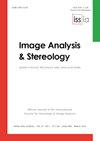A SHAPE-CONTEXT MODEL FOR MATCHING PLACENTAL CHORIONIC SURFACE VASCULAR NETWORKS
IF 1
4区 计算机科学
Q4 IMAGING SCIENCE & PHOTOGRAPHIC TECHNOLOGY
引用次数: 4
Abstract
Placental chorionic surface vascular networks (PCSVNs) are essential high-capacitance, low-resistance distribution and drainage networks, and are hence important to placental function and to fetal and newborn health. It was hypothesized that variations in the PCSVN structure may reflect both the overall effects of genetic and environmentally regulated variations in branching morphogenesis within the conceptus and the fetus’s vital organs. A critical step in PCSVN analysis is the extraction of blood vessel structure, which has only been done manually through a laborious process, making studies in large cohorts and applications in clinical settings nearly impossible. The large variation in the shape, color, and texture of the placenta presents significant challenges to both machine and human to accurately extract PCSVNs. To increase the visibility of the vessels, colored paint can be injected into the vascular networks of placentas, allowing PCSVNs to be manually traced with a high level of accuracy. This paper provides a proof-of-concept study to explain the geometric differences between manual tracings of paint-injected and un-manipulated PCSVNs under the framework of a shape-context model. Under this framework, paint-injected and un-manipulated tracings of PCSVNs can be matched with nearly 100% accuracy. The implication of our results is that the manual tracing protocol yields faithful PCSVN representations modulo a set of affine transformations, making manual tracing a reliable method for studying PCSVNs. Our work provides assurance to a new pre-processing approach for studying vascular networks by ways of dye-injection in medical imaging problems.胎盘绒毛膜表面血管网络匹配的形状-上下文模型
胎盘绒毛膜表面血管网络(PCSVNs)是必不可少的高电容、低电阻分布和引流网络,因此对胎盘功能和胎儿和新生儿健康至关重要。据推测,PCSVN结构的变化可能反映了母体和胎儿重要器官内分支形态发生的遗传和环境调节变化的总体影响。PCSVN分析的一个关键步骤是血管结构的提取,这一过程只能通过人工完成,这使得在大型队列研究和临床应用几乎不可能。胎盘的形状、颜色和质地的巨大变化给机器和人类准确提取pcsvn带来了重大挑战。为了增加血管的可见性,可以将彩色涂料注射到胎盘的血管网络中,从而使pcsvn能够以高水平的准确性进行人工追踪。本文提供了一项概念验证研究,以解释在形状-上下文模型的框架下,人工跟踪油漆注入和未操作的pcsvn之间的几何差异。在此框架下,pcsvn的注入油漆和未操作的跟踪可以以接近100%的精度匹配。我们的研究结果表明,手动跟踪协议对一组仿射变换产生忠实的PCSVN表示,使手动跟踪成为研究PCSVN的可靠方法。本研究为利用染料注射技术研究血管网络提供了一种新的预处理方法。
本文章由计算机程序翻译,如有差异,请以英文原文为准。
求助全文
约1分钟内获得全文
求助全文
来源期刊

Image Analysis & Stereology
MATERIALS SCIENCE, MULTIDISCIPLINARY-MATHEMATICS, APPLIED
CiteScore
2.00
自引率
0.00%
发文量
7
审稿时长
>12 weeks
期刊介绍:
Image Analysis and Stereology is the official journal of the International Society for Stereology & Image Analysis. It promotes the exchange of scientific, technical, organizational and other information on the quantitative analysis of data having a geometrical structure, including stereology, differential geometry, image analysis, image processing, mathematical morphology, stochastic geometry, statistics, pattern recognition, and related topics. The fields of application are not restricted and range from biomedicine, materials sciences and physics to geology and geography.
 求助内容:
求助内容: 应助结果提醒方式:
应助结果提醒方式:


